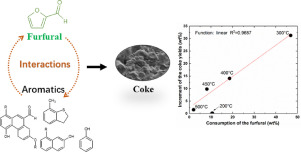Journal of Energy Chemistry ( IF 13.1 ) Pub Date : 2020-03-13 , DOI: 10.1016/j.jechem.2020.03.015 Zhe Xiong , Yuanjing Chen , Muhammad Mufti Azis , Xun Hu , Wei Deng , Hengda Han , Long Jiang , Sheng Su , Song Hu , Yi Wang , Jun Xiang

|
The reactive O-containing species in bio-oil could induce the polymerization of bio-oil during its thermal treatment, which affects the relevant utilization of bio-oil significantly. Furans, as the highly reactive O-containing species in bio-oil, play important roles during the thermal treatment of bio-oil. In this study, furfural was chosen as the representative of the furans in bio-oil to investigate its roles during the thermal treatment of bio-oil. The raw bio-oil with and without the addition of extra furfural (10 wt% of bio-oil) and pure furfural were pyrolyzed in a fixed-bed reactor at 200–500°C. The results show that the interactions among furfural and bio-oil components can take place prior to the evaporation of furfural (< 140°C) to form the intermediates, then these intermediates could be further polymerized to form large molecular compounds, and coke can be formed via the interactions at temperatures ≥ 300°C. At temperatures ≤ 300°C, furfural mainly interacts with anhydrosugars. As the temperature further increases, the aromatics are involved in the interactions to form coke. The increased percentage of the coke formed via the interactions is in a linear relation with the conversion of furfural during the pyrolysis at 300–500°C (no coke formed at 200°C). Meanwhile, more non-aromatic light components (≤ C6) and less aromatics in the tars could be formed due to the interactions.
中文翻译:

糠醛在低温生物油热处理中的作用
生物油中的反应性含O物质在热处理过程中会诱导生物油的聚合反应,从而显着影响生物油的相关利用。呋喃作为生物油中高反应性的含O物质,在生物油热处理过程中起着重要作用。在这项研究中,糠醛被选为生物油中呋喃的代表,以研究其在生物油热处理中的作用。在200-500的固定床反应器中,将有或没有添加额外糠醛(占生物油的10 wt%)和纯糠醛的原始生物油热解。℃。结果表明,糠醛和生物油成分之间的相互作用可以在糠醛蒸发之前发生(<140°C)形成中间体,然后这些中间体可以进一步聚合形成大分子化合物,并且可以通过在温度≥300下的相互作用形成焦炭℃。温度≤300°C,糠醛主要与脱水糖相互作用。随着温度进一步升高,芳族化合物参与相互作用而形成焦炭。在300–500的热解过程中,通过相互作用形成的焦炭百分比的增加与糠醛的转化成线性关系°C(200℃无结焦°C)。同时,由于相互作用,可以在焦油中形成更多的非芳香族轻组分(≤C 6)和更少的芳香族化合物。



























 京公网安备 11010802027423号
京公网安备 11010802027423号